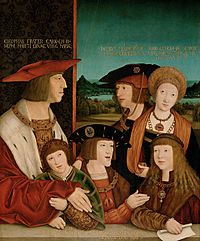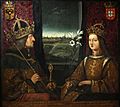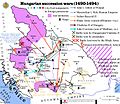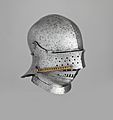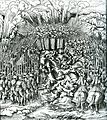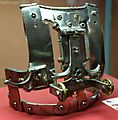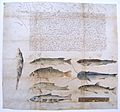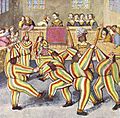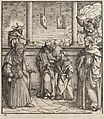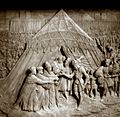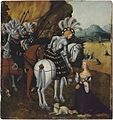Maximilian I, Holy Roman Emperor facts for kids
Quick facts for kids Maximilian I |
|
|---|---|
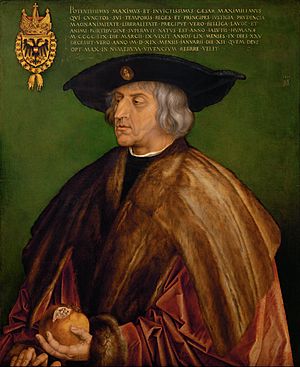
Portrait by Albrecht Dürer, 1519 (Kunsthistorisches Museum, Vienna). Maximilian holds his personal emblem, the pomegranate.
|
|
| King of Germany (King of the Romans) | |
| Reign | 16 February 1486 – 12 January 1519 |
| Coronation | 9 April 1486 |
| Predecessor | Frederick III |
| Successor | Charles V |
| Holy Roman Emperor, Archduke of Austria | |
| Reign | 19 August 1493 – 12 January 1519 |
| Predecessor | Frederick III |
| Successor | Charles V |
| Duke of Burgundy | |
| Reign | 5 January 1477 – 27 March 1482 |
| Predecessor | Mary the Rich |
| Successor | Philip IV |
| Burial | Wiener Neustadt, Austria |
| Spouse | Mary, Duchess of Burgundy Anne of Brittany{annulled} Bianca Maria Sforza |
| Issue | Philip I of Castile Margaret, Archduchess of Austria |
| House | House of Habsburg |
| Father | Frederick III |
| Mother | Eleanor of Portugal |
Maximilian I of Habsburg (22 March 1459 – 12 January 1519), the son of Frederick III, Holy Roman Emperor and Eleanor of Portugal, was King of the Romans from 1486 and Holy Roman Emperor from 1493 until his death. He had ruled jointly with his father for the last ten years of his father's reign, from circa 1483. He expanded the influence of the House of Habsburg through both war and marriage, but also lost the Austrian territories in today's Switzerland to the Swiss Confederacy.
By marrying his son Philip to then-Crown Princess Joanna of Castile in 1498, Maximilian established the Habsburg dynasty in Spain and allowed his grandson Charles to hold the throne of both León-Castile and Aragon, therefore causing him to be the first de jure King of Spain. Having outlived his father Philip, Charles succeeded Maximilian as Holy Roman Emperor in 1519, and thus ruled both the Holy Roman Empire and the Spanish Empire simultaneously.
Contents
Background
The son of the Habsburg Holy Roman Emperor Frederick III and Eleanor of Portugal, Maximilian was born at Wiener Neustadt on 22 March, 1459. At the time, the Dukes of Burgundy, a sidebranch of the French royal family, with their sophisticated nobility and court culture, were highly respected regents, and Duke of Burgundy Charles the Bold was the chief opponent of Maximilian's father Frederick III. Frederick was concerned of Burgundy's expansive tendencies on the western border of his Holy Roman Empire, leaging to him attempting to secure the marriage of Charles' only daughter Mary to his son Maximilian. In this, he was ultimately successful after the Siege of Neuss (1474–75). The wedding between Maximilian and Mary took place on the evening of August 16, 1477.
Reign in Burgundy and The Netherlands
Mary inherited the vast Burgundian domains in France and the Low Countries upon her father's death in the Battle of Nancy on 5 January 1477. Already before his crownation as the King of the Romans in 1486, Maximilian decided to secure this distant and extensive Burgundian inheritance to his family, the House of Habsburg, at all costs.
The Duchy of Burgundy was also been claimed by the French crown under Salic Law, and Louis XI, King of France contested the Habsburg claim to the Burgundian inheritance. Maximilian undertook the defence of his wife's dominions from an attack by Louis XI and defeated the French forces at Guinegatte, the modern Enguinegatte, on 7 August, 1479.
The wedding contract between Maximilian and Mary stipulated, that only the children of bride and groom had a right to inherit, but not the surviving parent. This precarious rule was transformed and bypassed by Maria with a promise to transfer as a gift in case of her death. After Mary's tragic death in a riding accident on 27 March 1482 near the Wijnendale Castle, Maximilian's aim was now to secure the inheritance to one of his and Mary's children, Philip the Handsome.
Some of the Netherland provinces were hostile to Maximilian, and they signed a treaty with Louis in 1482 which forced Maximilian to give Franche-Comté and Artois to Louis. Maximilian continued to govern Mary's remaining inheritance in the name of Philip the Handsome. After the regency ended, Maximilian and Charles VIII exchanged these two territories for Burgundy and Picardy in the Treaty of Senlis (1493). Thus ultimately much of the Netherlands became and remained a Habsburg possession.
Reign in the Holy Roman Empire
| Holy Roman Emperor |
|---|
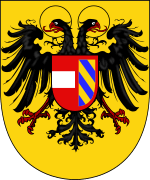 |
|
|
Elected King of the Romans (Rex Romanorum) 16 February 1486 in Frankfurt am Main at his father's initiative and crowned on 9 April 1486 in Aachen, Maximilian also stood at the head of the Holy Roman Empire upon his father's death in 1493.
Italian and Swiss wars
As the treaty of Senlis had solved the French's differences with the Holy Roman Empire, King of France Ludvig XII had his borders secured in the north and turned his attention to Italy, where he made claims for the Duchy of Milan. In 1499/1500 he conquered it and drove the Sforza regent Lodovico il Moro to exile. This brought him into a potential conflict with Maximilian, who on 16 March 1494 had married married Bianca Maria Sforza, a daughter of the Duke of Milan. However, Maximilian was unable to hinder the French from taking over Milan. The prolonged Italian Wars resulted, with Maximilian joining the Holy League to counter the French.
The situation in Italy was not the only problem Maximilian had at the time. The Swiss won a decisive victory against the Empire in the battle of Dornach 22 July 1499. Maximilian had no choice but to agree to a peace treaty signed on 22 September 1499 in Basel granting the Swiss Confederacy independence from the Holy Roman Empire. He is often referred to as "The Last Knight".
Reforms
Within the Holy Roman Empire, Maximilian faced pressure from regents who believed that the King's continued wars with French to increase the power of his own house were not in their best interests. However, consensus existed that in order to preserve the unity of the Empire, deep reforms were needed. The reforms, which had been delayed for a long time, were launched in the 1495 Reichstag at Worms. A new organ, the Reichskammergericht was introduced, and it was to be largely independent from the King. To finance it, a new tax, the Gemeine Pfennig was launched. However, its collection was never fully successful. The regents wanted to more independence from the King and a strengthening of their own territorial rule. This led to Maximilian agreeing to establish an organ called the Reichsregiment, which would meet in Nürnberg and consist of the deputies of the King, the regents, the classes and the prince electors. The new organ proved itself relatively powerless and its power returned to Maximilian again in 1502.
Due to the difficult external and internal situation, Maximilian also felt it necessary to introduce reforms on the lands of the House of Habsburg, in order to finance his army. Using the Burgundian institutions as an ideal, he attempted to create a unified state. This was not very successful, but one of the lasting results was the creation of three different subdivions. These included Lower Austria, Upper Austria, and Vorderösterreich.
In 1508, Maximilian, with Pope Julius II's assent, took the title of Erwählter Römischer Kaiser ("Elected Roman Emperor"), thus ending the centuries-old custom that the Holy Roman Emperor had to be crowned by the pope.
Tu felix Austria nube
As part of the Treaty of Arras, Maximilian betrothed his three-year-old daughter Margaret to the Dauphin (later Charles VIII), son of his adversary Louis XI. Louis had attempted seven years earlier to arrange a betrothal between the Dauphin and Margaret's mother, Mary. Under the terms of Margaret's betrothal, she was sent to Louis to be brought up under his guardianship. Despite the death of Louis in 1483, shortly after Margaret arrived in France, she remained at the French court. The Dauphin, now Charles VIII, was still a minor, and his regent until 1491 was his sister, Anne of France. Anne's first betrothal, to the Duke of Lorraine, had ended when the Duke broke it off in order to pursue Mary of Burgundy (and died shortly afterwards). Despite Margaret's betrothal and continued presence at the French court, Anne arranged a marriage between Charles and Anne of Brittany. She, in turn, had been betrothed in 1483, and actually married by proxy in 1491, to Maximilian himself, but Charles and his sister wanted her inheritance for France. The final result of all of these machinations was that Charles repudiated his betrothal to Margaret when he came of age in 1491, invaded Brittany, forced Anne of Brittany to repudiate her unconsummated marriage to Maximilian, and married her. (They had four children who all died in infancy, and after Charles died, his widow married his cousin and successor, Louis XII.) Margaret still remained in France until 1493, when she was finally returned to her father. She married twice more.
In 1493, Maximilian contracted another marriage for himself, this time to the daughter of the Duke of Milan, whence ensued the lengthy Italian Wars with France. Thus Maximilian through his own marriages (and attempted marriage) sought to extend his sphere of influence against that of France. The marriages he arranged for both of his children more successfully fulfilled the same goal, and after the turn of the sixteenth century, his matchmaking focused on his grandchildren, for whom he looked opposite France towards the east.
In order to reduce the growing pressures on the Empire brought about by treaties between the rulers of France, Poland, Hungary, Bohemia, and Russia, as well as to secure Bohemia and Hungary for the Habsburgs, Maximilian I met with the Jagiellonian kings Ladislaus II of Hungary and Bohemia and Sigismund I of Poland at the First Congress of Vienna in 1515. There they arranged for Maximilian's granddaughter Mary to marry Louis, the son of Ladislaus, and for Anne (the sister of Louis) to marry Maximilian's grandson Ferdinand(both grandchildren being the children of Philip the Handsome, Maximilian's son, and Juana la Loca of Castile). The marriages arranged there brought Habsburg kingship over Hungary and Bohemia in 1526. Both Anne and Louis were adopted by Maximilian following the death of Ladislaus. These political marriages were summed up in the following Latin elegiac couplet: Bella gerant aliī, tū fēlix Austria nūbe/ Nam quae Mars aliīs, dat tibi regna Venus, "Let others wage war, but thou, O happy Austria, marry; for those kingdoms which Mars gives to others, Venus gives to thee."
Death and legacy
In 1501, Maximilian fell from his steed. The accident badly injured his leg, which caused him pain for the rest of his life. Some historians have suggested that Maximilian was "morbidly" depressed: From 1514, he travelled everywhere with his coffin. Maximilian died in Wels, Upper Austria, and was succeeded as Emperor by his grandson Charles V, his son Philip the Handsome having died in 1506. Although he is buried in the Castle Chapel at Wiener Neustadt, a cenotaph tomb for Maximilian is located in the Hofkirche, Innsbruck.
Maximilian was a keen supporter of the arts and sciences, and he surrounded himself with scholars such as Joachim Vadian and Andreas Stoberl (Stiborius), promoting them to important court posts. His reign saw the first flourishing of the Renaissance in Germany. He commissioned a series of three monumental woodblock prints - The Triumphal Arch (1512–18, 192 woodcut panels, 295 cm wide and 357 cm high - approximately 9'8" by 11'8½"), and a Triumphal Procession (1516–18, 137 woodcut panels, 54 m long) which is led by a Large Triumphal Carriage (1522, 8 woodcut panels, 1½' high and 8' long), created by artists including Albrecht Dürer, Albrecht Altdorfer and Hans Burgkmair.
Maximilian had a great passion for armour, not only as equipment for battle or tournaments but as an art form. The style of armour that became popular during the second half of his reign featured elaborate fluting and metalworking, and became known as Maximilian armour after the Emperor. Maximilian armour emphasized the details in the shaping of the metal itself, rather than the etched or gilded designs popular in the Milanese style. Maximilian also gave a bizarre jousting helmet as a gift to King Henry VIII - the helmet's visor featured a human face, with eyes, nose and a grinning mouth, and was modeled after the appearance of Maximilian himself. It also sported a pair of curled ram's horns, brass spectacles, and even etched beard stubble.
Maximilian had appointed his daughter Margaret as both Regent of the Netherlands and the guardian and educator of his grandsons Charles and Ferdinand (their father, Philip, having predeceased Maximilian), and she fulfilled this task well. Through wars and marriages he extended the Habsburg influence in every direction: to the Netherlands, Spain, Bohemia, Hungary, Poland, and Italy. This influence would last for centuries and shape much of European history.
Titles
Maximilian I, by the grace of God elected Holy Roman Emperor, forever August, King of Germany, of Hungary, Dalmatia, Croatia, etc. Archduke of Austria, Duke of Burgundy, Brabant, Lorraine, Styria, Carinthia, Carniola, Limburg, Luxembourg, Gelderland, Landgrave of Alsace, Prince of Swabia, Count Palatine of Burgundy, Princely Count of Habsburg, Hainaut, Flanders, Tyrol, Gorizia, Artois, Holland, Seeland, Ferrette, Kyburg, Namur, Zutphen, Margrave of the Holy Roman Empire, the Enns, Burgau, Lord of Frisia, the Wendish March, Pordenone, Salins, Mechelen, etc. etc.
Marriages and offspring
Maximilian was married three times, of which only the first marriage produced offspring:
- Mary of Burgundy (1457–1482). They were married in Ghent on 18 August 1477, and the marriage was ended by Mary's death in a riding accident in 1482. The marriage produced three children:
- Philip the Handsome (1478–1506) who inherited his mother's domains following her death, but predeceased his father. He married Joanna of Castile, becoming King-consort of Castile upon her accession in 1504, and was the father of the Holy Roman Emperors Charles V and Ferdinand I
- Margaret of Austria, (1480–1533), who was first engaged at the age of 2 to the French Dauphin (who became Charles VIII of France a year later) to confirm peace between France and Burgundy. She was sent back to her father in 1492 after Charles repudiated their betrothal to marry Anne of Brittany. She was then married to the Crown Prince of Castile and Aragon John, Prince of Asturias, and after his death to Philibert II of Savoy, after which she undertook the guardianship of her deceased brother Philip's children, and governed Burgundy for the heir, Charles.
- Francis of Austria, who died shortly after his birth in 1481.
- Anne of Brittany (1477–1514) — they were married by proxy in Rennes on 18 December 1490, but the contract was dissolved by the Pope in early 1492, by which time Anne had already been forced by the French King, Charles VIII (the fiancé of Maximilian's daughter Margaret of Austria) to repudiate the contract and marry himself instead.
- Bianca Maria Sforza (1472–1510) — they were married in 1493, the marriage bringing Maximilian a rich dowry and allowing him to assert his rights as Imperial overlord of Milan. The marriage was unhappy, and they had no children.
- By Margareta Von Edelsheim, Maximilian is alleged to have been the father of:
- Margareta (1480–1537) wife of Count Ludwig Von Helfenstein-Wiesentheid, was killed by peasants on 16 April 1525 in the Massacre of Weinsberg during the Peasants' War.
Images for kids
-
Maximilian offers Mary of Burgundy an engagement ring. Miniature in a medieval manuscript copy of the Excellent Chronicle of Flanders by Anthonis de Roovere. Ca. 1485–1515. (Bruges Public Library Ms. 437)
-
The Judgment of Cambyses, Bruges's symbolic apology to Maximilian. In a twist, the corrupted judge had the likeness of Maximilian's hated official Peter Lanchals, who was executed by Bruges. Painted by Gerard David. Previously, when Maximilian was moved to Jean Gros's mansion, his second prison, Bruges hired David to paint the strong iron gratings, added to the windows to prevent escape, in order to amuse the prisoner, whom they tried to cheer up in various ways.
-
Succession wars in Hungary after the death of Matthias Corvinus (Vladislas marked dark red)
-
Sallet of Maximilian I, c. 1490–95, by Lorenz Helmschmid, Metropolitan Museum of Art.
-
Maximilian I paying attention to an execution instead of watching Philip the Handsome and Joanna of Castile's betrothal, much to his son's dismay. The top right corner shows Cain and Abel. Satire against Maximilian's legal reform. Created on behalf of the councilors of Augsburg. Plate 89 of Von der Arztney bayder Glück by the Petrarcameister.
-
19th century reproduction (by Julien Bernard Van der Plaetsen) of a 1507 fresco depicting Mary of Burgundy and Maximilian holding the coat of arms of Burgundy. The couple stood as a pair of equals, similar to other portrayals, despite Maximilian's status as Emperor. The original work was created to celebrate Charles's status as the new Duke of Burgundy.
-
The arsenal in Lindau. The construction started in 1507 but only finished in 1526, after Maximilian's death.
-
Behamisch facht (Bohemian battle) from the Weißkunig, Woodcut 175, depicting the Battle of Wenzenbach, one of the last knights' battles (1504), which was won by Maximilian and his ally Albert the Wise. In this battle, Maximilian was dragged from his horse by halberds, but rescued from being butchered by Erich von Braunschweig.
-
HJRK B 21 - Mechanical breastpiece used for Bundrennen, a tournament type which was probably only organized in the Imperial Court, c. 1490. Only three mechanical breastplates remain (one in Paris, two in Vienna). The breastplate was designed to carry a shield that, when hit properly, will be ejected over the jouster's head and burst apart, releasing triangle tin segments.
-
Maximilian's Fishing Code for Upper and Lower Austria, 1506. The species illustrated here (from left) are zingel, pike, carp, barbel, huchen, burbot, catfish and trout. Despite its disguise as a mandate (that has never been disseminated or put into practice; the content is also not consistent), this is apparently a work of art that is influenced by or tries to compete with Albrecht Dürer's naturalist drawings. The Chancellery notation suggests the emperor's personal involvement in developing the document.
-
Hans Burgkmair, The Imperial Eagle, 1507, NGA 39804. The Imperial Eagle is sheltering Maximilian, presented here as a seated Apollo, the Muses and other figures. This is considered an allegory, suggested by Konrad Celtis (bottom figure), of the emperor, the University of Vienna and the Empire. Apollo was the god often associated with the emperor by many artists and humanists, who designed a mission for him not only as the promoter of arts and sciences but also in the realm of politics. Under the wings is the scientific model of the University of Vienna, designed by Celtis.
-
Black Hours of Galeazzo Maria Sforza, M 1856, now in the Austrian National Library in Vienna (Codex Vindobon. 1856). The book was made for Maximilian's future father-in-law Charles the Bold in 1466 by Bruges, then given to Galeazzo Maria Sforza likely in 1475–76 during his and Charles's brief alliance, became Bianca Maria Sforza's property, and was finally brought to Maximilian's library after Bianca's and Maximilian's marriage in 1494.
-
Ensisheim meteorite, National Museum of Natural History, France
-
Assumption of the Virgin from the Berlin Book of hours of Mary of Burgundy and Maximilian, Staatliche Museen zu Berlin, Kupferstichkabinett Handschrift 78 B 12 (Photo Credit: Bildarchive Preussischer Kulturbesitz/Art Resource, NY). "And a great sign appeared in heaven: A woman clothed with the sun, and the moon under her feet, and on her head a crown of twelve stars."
-
Albrecht Dürer - Feast of the Rosary, 1506. Dürer started the work for the German-speaking community of Venice, who were united as a Fraternity of the Rosary. The figure of the Virgin alludes to Mary of Burgundy while the infant Jesus is associated with Philip the Fair. Here the Wise King, or White King, claimed his legitimacy directly from the omnipotent Queen of Heaven, rather than through the mediation of the Church and the Pope.
-
Maximilian in the last year of his life, holding his personal emblem, a pomegranate. Portrait by Albrecht Dürer, 1519.
See also
 In Spanish: Maximiliano I de Habsburgo para niños
In Spanish: Maximiliano I de Habsburgo para niños




